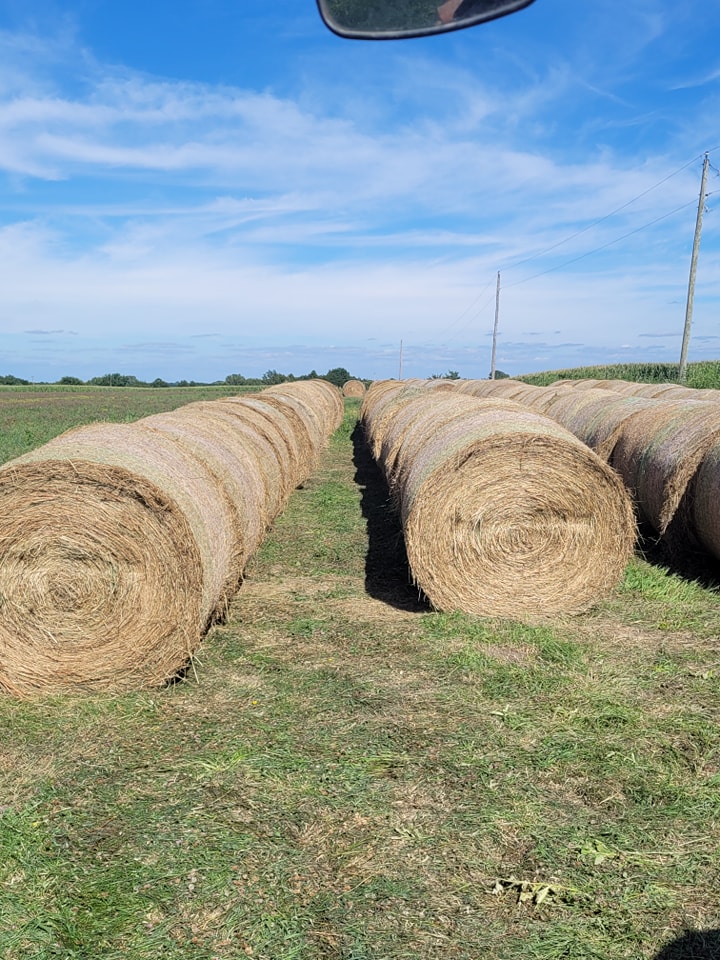HAY
| CHEMICAL COMPOSITION OF HAY | ||||||
| Description | Water | Ash | Albumin-
ooids |
Crude
Fiber |
Extractive Matter Free From Nitrogen | Fat |
| ALFALFA | 8.4 | 7.4 | 14.3 | 25.0 | 42.7 | 2.2 |
| BARLEY | 10.6 | 5.3 | 9.3 | 23.6 | 48.7 | 2.5 |
| BROME GRASS | 11.0 | 9.5 | 11.6 | 30.8 | 35.2 | 1.8 |
| COWPEA | 10.7 | 7.5 | 16.6 | 20.1 | 42.2 | 2.9 |
| CRIMSON CLOVER | 9.6 | 8.6 | 15.2 | 27.2 | 36.6 | 2.8 |
Hay can be used as animal fodder when or where there is not enough pasture or rangeland on which to graze an animal, when grazing is not feasible due to weather (such as during the winter), or when lush pasture by itself would be too rich for the health of the animal. It is also fed when an animal is unable to access pasture—for example when the animal is being kept in a stable or barn.
Hay is very sensitive to weather conditions, especially when it is harvested. In drought conditions, both seed and leaf production are stunted, making hay that has a high ratio of dry coarse stems that have very low nutritional values. If the weather is too wet, the cut hay may spoil in the field before it can be baled. Thus, the biggest challenge and risk for farmers in producing hay crops is the weather, especially the weather of the particular few weeks when the plants are at the best age or maturity for hay. A lucky break in the weather often moves the haymaking tasks (such as mowing, tedding, and baling) to the top priority on the farm’s to-do list. This is reflected in the idiom to make hay while the sun shines. Hay that was too wet at cutting may develop rot and mold after being baled, creating the potential for toxins to form in the feed, which could make the animals sick.
After harvest, hay also has to be stored in a manner to prevent it from getting wet. Mold and spoilage reduce nutritional value and may cause illness in animals. A symbiotic fungus in fescue may cause illness in horses and cattle.
Poor-quality hay is dry, bleached out, and coarse-stemmed. Sometimes, hay stored outdoors will look like this on the outside but still be green inside the bale. A dried, bleached, or coarse bale is still edible and provides some nutritional value as long as it is dry and not moldy, dusty, or rotting.
The successful harvest of maximum yields of high-quality hay is entirely dependent on the coincident occurrence of optimum crop, field, and weather conditions. When this occurs, there may be a period of intense activity on the hay farm while harvest proceeds until weather conditions become unfavorable.
Hay or grass is the foundation of the diet for all grazing animals and can provide as much as 100% of the fodder required for an animal. Hay is usually fed to an animal during times when winter, drought, or other conditions make pasture unavailable. Animals that can eat hay vary in the types of grasses suitable for consumption, the ways they consume hay, and how they digest it. Therefore, different types of animals require hay that consists of similar plants to what they would eat while grazing, and, likewise, plants that are toxic to an animal in pasture are generally also toxic if they are dried into hay.
Most animals are fed hay in two daily feedings, morning and evening, more for the convenience of humans, as most grazing animals on pasture naturally consume fodder in multiple feedings throughout the day. Some animals, especially those being raised for meat, may be given enough hay that they simply are able to eat all day. Other animals, especially those that are ridden or driven as working animals may be given a more limited amount of hay to prevent them from getting too fat. The proper amount of hay and the type of hay required varies somewhat between different species. Some animals are also fed concentrated feeds such as grain or vitamin supplements in addition to hay. In most cases, hay or pasture forage must make up 50% or more of the diet by weight.
One of the most significant differences in hay digestion is between ruminant animals, such as cattle, sheep, and nonruminant, hindgut fermenters such as horses. Both types of animals can digest cellulose in grass and hay but do so by different mechanisms. Because of the four-chambered stomach of cattle, they are often able to break down older forage and have more tolerance to mold and changes in diet. The single-chambered stomach and cecum or “hindgut” of the horse use bacterial processes to break down cellulose that is more sensitive to changes in feeds and the presence of mold or other toxins, requiring horses to be fed hay of a more consistent type and quality.
These round bales have been left in the field for many months, perhaps more than a year, exposed to weather, and appear to be rotting. Not all animals can safely eat hay with rot or mold.
Different animals also use hay in different ways: cattle evolved to eat forages in relatively large quantities at a single feeding, and then, due to the process of rumination, take a considerable amount of time for their stomachs to digest food, often accomplished while the animal is lying down, at rest. Thus, the quantity of hay is important for cattle, who can effectively digest hay of low quality if fed in sufficient amounts. Sheep will eat between two and four percent of their body weight per day in dry feed, such as hay, and are very efficient at obtaining the most nutrition possible from three to five pounds per day of hay or other forage. They require three to four hours per day to eat enough hay to meet their nutritional requirements.
Unlike ruminants, horses digest food in small portions throughout the day, and can only use approximately 2.5% of their body weight in feed in any 24-hour period. They evolved to be continuously on the move while grazing (covering up to 50 miles (80 km) per day in the wild) and their stomach digests food quite rapidly. Thus, they extract more nutrition out of smaller quantities of feed. When horses are fed low-quality hay, they may develop an unhealthy, obese, “hay belly” due to over-consumption of “empty” calories. If their type of feed is changed dramatically, or if they are fed moldy hay or hay containing toxic plants, they can become ill; colic is the leading cause of death in horses. Contaminated hay can also lead to respiratory problems in horses. Hay can be soaked in water, sprinkled with water, or subjected to steaming to reduce dust.

